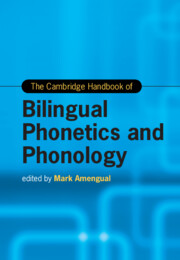Book contents
- The Cambridge Handbook of Bilingual Phonetics and Phonology
- Cambridge Handbooks in Language and Linguistics
- The Cambridge Handbook of Bilingual Phonetics and Phonology
- Copyright page
- Dedication
- Contents
- Figures
- Tables
- Contributors
- Acknowledgments
- Introduction Bilingual Phonetics and Phonology
- Part I Approaches to Bilingual Phonetics and Phonology
- Part II Theoretical Models of Bilingual Phonetics and Phonology
- Part III The Phonetics and Phonology of the Bilingual Child
- Part IV The Phonetics and Phonology of the Bilingual Adult
- Part V The Diversity of Bilingual Speakers
- 22 The Phonetics and Phonology of Early Bilinguals
- 23 The Phonetics and Phonology of Adult L2 Learners in the Classroom
- 24 The Phonetics and Phonology of Adult L2 Learners After Study Abroad
- 25 The Phonetics and Phonology of Heritage Language Speakers
- 26 The Phonetics and Phonology of Indigenous Language Bilinguals
- 27 The Phonology of Bimodal Bilinguals
- 28 Comparing Bilingual and Trilingual Phonetics and Phonology
- Part VI Variables and Outcomes of Bilingual Speech
- Index
- References
22 - The Phonetics and Phonology of Early Bilinguals
from Part V - The Diversity of Bilingual Speakers
Published online by Cambridge University Press: 14 November 2024
- The Cambridge Handbook of Bilingual Phonetics and Phonology
- Cambridge Handbooks in Language and Linguistics
- The Cambridge Handbook of Bilingual Phonetics and Phonology
- Copyright page
- Dedication
- Contents
- Figures
- Tables
- Contributors
- Acknowledgments
- Introduction Bilingual Phonetics and Phonology
- Part I Approaches to Bilingual Phonetics and Phonology
- Part II Theoretical Models of Bilingual Phonetics and Phonology
- Part III The Phonetics and Phonology of the Bilingual Child
- Part IV The Phonetics and Phonology of the Bilingual Adult
- Part V The Diversity of Bilingual Speakers
- 22 The Phonetics and Phonology of Early Bilinguals
- 23 The Phonetics and Phonology of Adult L2 Learners in the Classroom
- 24 The Phonetics and Phonology of Adult L2 Learners After Study Abroad
- 25 The Phonetics and Phonology of Heritage Language Speakers
- 26 The Phonetics and Phonology of Indigenous Language Bilinguals
- 27 The Phonology of Bimodal Bilinguals
- 28 Comparing Bilingual and Trilingual Phonetics and Phonology
- Part VI Variables and Outcomes of Bilingual Speech
- Index
- References
Summary
This chapter provides a thorough, up-to-date review of the literature on the phonetics and phonology of early bilinguals. It pulls together studies from a range of bilingual settings, including bilingual societies and heritage language contexts. While the chapter mostly reviews evidence from adolescent and adult participants, it also makes reference to the child bilingualism literature, where appropriate. The chapter first reviews studies on the accents of early versus late bilinguals, followed by a discussion of the various explanatory accounts for the observed differences between these two groups. Subsequently, the critical significance of early linguistic experience on bilingual speech patterns is considered, with particular reference to the evidence from childhood overhearers and international adoptees. The following sections then review studies comparing simultaneous and early sequential bilinguals, and those exploring the role of language dominance, continued use, the language of the environment in bilinguals’ pronunciation patterns, and the role of sociolinguistic factors in early bilingual speech patterns. The chapter concludes with suggestions for future research.
Keywords
- Type
- Chapter
- Information
- The Cambridge Handbook of Bilingual Phonetics and Phonology , pp. 501 - 520Publisher: Cambridge University PressPrint publication year: 2024

